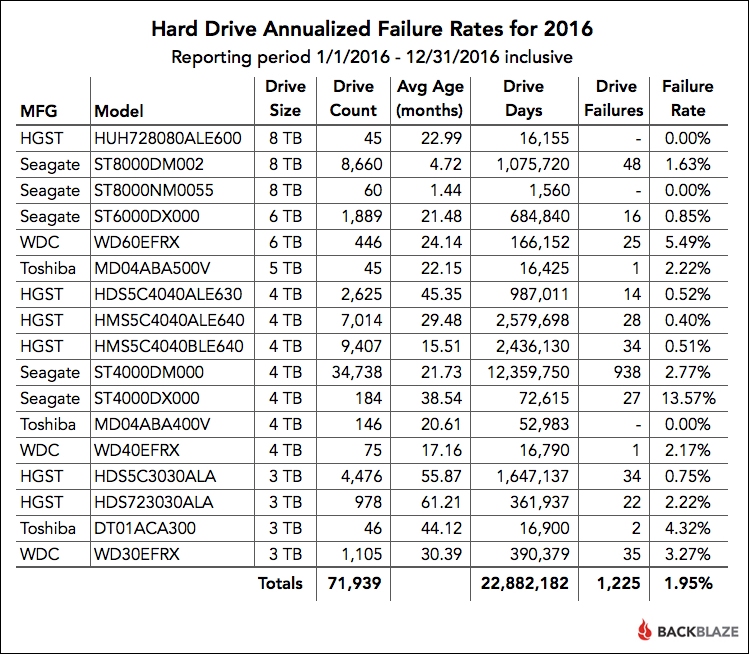

For most normal PC and Mac personal computer users, the cost dictates the second option.Īnother factor is there is no such thing today as permanent storage technology for the masses.
#Backblaze hard drive stats professional
So what’s a computer user to do? Essentially there are two choices today for serious archiving: either spend big money to record your data on a professional magneto-optical or other archival media for long term backup or use a combination of hard drives, SSD and cloud backup. So somewhere between 6-10 years, your data is going to disappear because the magnetic field is no longer strong enough to retain the data. No magnetic drive company claims its products can store data reliably for more than 10 years. The rule of thumb is all magnetic media, like that used in hard drives, has a half-life of about five years. Though the Backblaze data can help us small-scale users determine which models to buy, there is still no guarantee the drive won’t fail.


Backblaze has 250 Dell DellBoss VD SSD drives. Its AFR was even more impressive at 0.36%. The company also has 562 Seagate ZA250CM10002 drives. There are only four of them in use and one of them failed.īackblaze uses 1,090 of the Seagate ZA250CM10003 drives and it had a 1.04% AFR in 2021. The situation is more extreme with the Seagate drive in question. While there’s a high AFR, there’s a low sample size and a wide confidence interval. Backblaze uses only 20 Crucial drives, and they were all installed in December. This cuts the number of models down to 13, and the model with the highest failure rate here is a 12TB Seagate model (ST12000NM0007) with an AFR of 2.03 percent.The overall number of these SSD drives, however, is much lower than hard drives. Backblaze, long a champion of home-grown hardware, succumbs to the lure of commodity serversįor this reason, the company has drawn up another table comprising drives which have a minimum drive days value of one million and are larger than 8TB in capacity.Back up for a minute – Backblaze HD reliability stats show oldies can be goodies.Toshiba reveals 30TB disk drive to arrive by 2024.Backblaze report finds SSDs as reliable as HDDs.However, Backblaze cautions that the number of “drive days” (the number of days all the drives of a specific model were operational during the defined period) for these is on the low side, leading to a wide gap between the low and high confidence interval values and therefore lower confidence in those AFR figures. Three drives can be picked out from the table with the highest failure rates, and these are an 8TB HGST model (HUH728080ALE604) at 6.26 percent a Seagate 14TB model (ST14000NM0138) at 4.86 percent and Toshiba’s 16TB (MG08ACA16TA) with 3.57 percent. But, as with the 4TB Toshiba model, these drives have very wide confidence interval gaps because of a relatively limited number of data points.īackblaze found that the lifetime AFR across all these drives is 1.39 percent, which is the same as during the previous quarter and down from the 1.45 percent found during the same quarter in 2021. Other drives that Backblaze reveals as having zero failures during Q2 are an 8TB HGST model (HUH728080ALE604), as well as some 14TB and 16TB Toshiba drives (MG07ACA14TEY and MG08ACA16TA respectively). The AFR for these drives is just 0.79 percent, but this comes with the caveat that the lifetime confidence interval gap for them is 1.3 percent, which means Backblaze is lacking enough data to be confident of the true AFR. However, the next to oldest drives in Backblaze’s portfolio are 4TB Toshiba drives (model MD04ABA400V) which have been in service for an average 85.3 months and these recorded zero failures during Q2. “At some point in the future we can expect these drives will be cycled out, but with their lifetime AFR at just 0.87 percent, they are not first in line,” said Backblaze’s principal cloud storage evangelist Andy Klein.


 0 kommentar(er)
0 kommentar(er)
